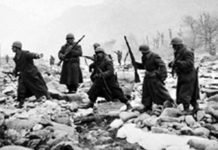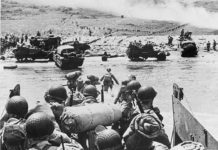The Battle of Sedgemoor was the final time two armies fought each other in England but it did not end the conflict between king and parliament
In the early hours of 6 July 1685, the last battle in England took place at Sedgemoor, an area of marshy, low-lying land near the town of Bridgwater in the county of Somerset.
A rebel army of 3,000 led by the pretender to the throne, James Scott, the Duke of Monmouth, had set out on a night march to surprise the army of King James II. By first light only one James would be King.
The cause
The Duke of Monmouth was the illegitimate son of King Charles II, son of the executed Charles I. He was born in exile in the Netherlands in 1649 and grew into a popular young man, fighting in several wars on the continent and returning to England when Charles II was restored to the throne in 1660. He left for the Netherlands in 1683 after being implicated in a plot against his father.
Charles II died without heir in 1685 leaving the crown to his brother, the Catholic King James II. There was still much suspicion in the country of Catholic kings and it was feared that James was becoming an autocrat with his disdain for parliament and persecution of the Whigs (those who wanted a better balance between the monarch and parliament).
Monmouth was a popular Protestant pretender to the throne but could he lead people to overthrow the King?
The campaign
With a small band of followers, Monmouth landed at Lyme Regis on the English south coast on 11 June. He marched through towns in the West Country being crowned King in Chard, Taunton and Bridgwater.
He had some soldiers of experience such as some Dutch cannon crew and a few former soldiers in the ranks but most of his army were enthusiastic town and country people fired up by the prospect of a Protestant King (see the Appendix to Monmouths Rebels by Peter Earle, which suggests it was the townsfolk, the middling sort, that supported the rebellion).
The area had a strong dissenting tradition and the Whigs were strong in the region (see p376, The History of England: from the succession of James II, Thomas Babington Macauley). But since the restoration of Charles II the area had suffered persecution.
Monmouth failed to win over any of the professional troops and few of the local militia and while early on his army reached nearly 7,000 men it fared badly in skirmishes with trained troops and suffered desertion (see chapter 2, Marlborough by Richard Holmes).
The rebel army marched on Bristol, then one of the major cities in England, but was barred from entering. It retreated back into the West Country harried by royalist troops led by Lord Feversham and colonel John Churchill, who had fought under Monmouth on the continent.
The Royalist Army pursued Monmouths dwindling army to Bridgwater and camped outside at the village of Weston Zoyland.
The battle
Monmouth decided on a decisive battle. His army marched out in the night in an attempt to surprise the Royalists.
About a mile from the camp, a shot was fired alarming royalist sentries, the Kings army quickly broke camp and formed up. Sometime after 1am, the rebel army, now consisting of about 3,000 men organised into five regiments and some 500 cavalry, rushed across the levels to encounter the royalist army, also about 3,000 strong.
Most of the rebel cavalry fled after receiving a volley of shot, plunging into their own foot regiments as they vacated the field of battle.
The rebel soldiers found their way blocked by a drainage ditch, refusing to cross and starting a fire fight with the trained and better-armed royalist regiments (there is some dispute whether the ditch was filled by water as July was high summer, see The Battlefields of England, chapter 19, by Alfred H Burne)
The superior muskets and cannon of the Kings army took their toll and by daybreak (between 3am and 4am) the rebel army was fleeing the battlefield.
An account of the battle from Colonel Wade, who was in command of a regiment in Monmouths army, tells of the rout of the rebel army.
“We continued in that station firing for about an hour and a half, when it being pretty light, I perceived all the battalions on the left, running (who, as I since understood, were broken by the Kings horse of the left wing), and finding my own men not inclinable to stand, I caused them to face about, and made a kind of disorderly retreat to a ditch a great way behind us, where we were charged by a party of horse and dragoons, and routed; above one hundred and fifty getting over the ditch. I marched with them on foot to Bridgwater.” (See account at UK Battlefields Trust)
The battle lasted for less than two hours, about 400 rebels were killed in battle but many more in the pursuit. A few dozen soldiers of the king.
The aftermath
Monmouth was captured a few days later. He was taken to London and despite pleading for his life was executed on 15 July 1685, with the executioner taking five attempts to behead him.
A list of 2,611 people who supposedly particpated in the rebellion was made, known as the Monmouth Roll, with further lists boosting the total to nearly 4,000 (see Appendix, The Monmouth Rebels by Earle).
The West Country was subjected to a reign of judicial terror. Judge Jeffreys carried out his “bloody assizes” with several hundred executions, upwards of one thousand people transported or sold into slavery in the Americas and many more imprisoned. In one day at Wells he sentenced 500 people and another 500 were sentenced over two days at Taunton.
Hanging and quartering were used to instill terror into the local population.
“This horrifying spectacle included public hanging, disembowelling and then quartering, after which the heads and quarters were dipped in pitch and salt and sent to villages around to be displayed in public on poles.” (Somerset County Records)
But King Jamess position was not secure. His Catholicism and attempts to become an “absolute monarch” with no regard to parliament or tradition made him even more unpopular.
In 1688 William of Orange invaded with a far bigger army than Monmouths and won over greater support, including John Churchill who had fought Monmouth and who became Williams most exulted general the Duke of Marlborough. William drove King James out of the country into Ireland without a battle and defeated him there in 1691. But it took until 1746 and the Battle of Culloden for the Jacobite cause (Jacobites after the Latin for James) to be finally defeated.
Monmouths rebellion was the penultimate act in the struggle to have a Protestant King and a constitutional monarchy in England. The invasion of King William III ushered in the Glorious Revolution of the Bill of Rights, restraints on the power of the monarchy and the supremacy of Parliament.
Bridgwater and anti-slavery
Judge Jeffreys was locked in the Tower of London by William III and died in 1691, but some good came out of his evil work in the West Country.
The memory of the assizes lived on locally and Bridgwater became the first town in England to vote against the slave trade and in 1846 Frederick Douglass visited and spoke at a meeting of townspeople about the conditions of American slaves.
References
UK Battlefields Trust has eyewitness accounts of the battle and maps
Somerset County Council History of the battle and aftermath has much local detail
The Battlefields of England, chapter 19, by Alfred H Burne, Methuen 1973
The Monmouth Rebels: The Road to Sedgemoor by Peter Earle, Weidenfield and NIcholson 1977.
The History of England: from the succession of James II, Thomas Babington Macauley, Boston 1849
Marlborough: Englands Fragile Genius, by Richard Holmes, Harper Collins 2008
West Country History: Somerset, chapter four, by Muriel Searle, Intellect Books 2002








